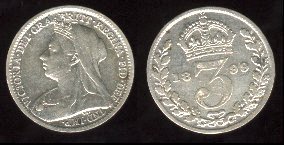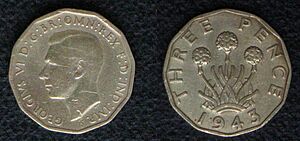History of the threepence facts for kids
The threepence or threepenny bit was a special coin used in places like England, Ireland, Scotland, and Wales. It was worth 1/80 of a pound or a quarter of a shilling. This was before 1971, when the money system changed to decimal (like our money today, based on tens). This coin was also used in some countries that were part of the British Empire, such as Australia, New Zealand, and South Africa.
Before 1971, people said "threepence" in different ways depending on where they lived. The coin itself was often called a "threepenny bit."
Contents
- First Threepence Coins
- Threepence Coins Return
- Mid-to-Late 1600s Coins
- Early 1700s Coins
- Changing Purpose of the Coin
- Queen Victoria's Threepence
- Early 1900s Coins
- Brass vs. Silver Threepence
- Elizabeth II Threepence
- Threepence in Other Countries
- The "Threepenny Bit Building"
- The 12-Sided Coin Returns
- See also
First Threepence Coins
The threepence coin, often written as "3d," first appeared in England during the time of King Edward VI (1547–1553). It was part of a new set of coins. Even though it fit well into the old money system (being a quarter of a shilling), people didn't really like it at first. They preferred the four-pence coin called a groat. Because of this, the threepence wasn't made during the next two kings' reigns.
Edward VI's threepence coins were made in London and York. The front of the coin showed the king's face, with a rose on one side and the number III (for three) on the other. Around it, it said "EDWARD VI D G ANG FRA Z HIB REX" (which means "Edward VI, by the Grace of God, King of England, France, and Ireland"). The back showed a cross over the royal shield.
Elizabeth I (1558–1603) also made threepence coins. You could tell her coins apart by a rose behind her head on the front and the date on the back. The front showed her crowned head with a rose, and the back had a shield over a cross with the date.
The threepence coin wasn't made much during the time of King James I. During King Charles I's reign (1625–1649), it wasn't made in London, but in other cities. These coins had the number III behind the king's head to show their value.
Threepence Coins Return
Many of Charles I's threepence coins were made in Aberystwyth between 1638 and 1642. These coins showed the king's crowned head with feathers (called plumes) in front and the number III behind him. The back had the royal arms on a shield. The plumes were a special symbol for the Aberystwyth mint.
Coins were also made in Oxford between 1644 and 1646. Some of these coins had a special message on the back called the "Declaration of Oxford." It said, "The religion of the Protestants, the laws of England, the liberty of Parliament."
The mint in Bristol also made rare threepence coins in 1644 and 1645, which also featured the "Declaration of Oxford."
The Exeter mint made a somewhat rare threepence in 1644. It showed the king's crowned head with the number III behind him, and the royal arms on the back with the date.
No threepence coins were made during the time of the Commonwealth.
Mid-to-Late 1600s Coins
The last threepence coins made by hammering metal were at the start of King Charles II's reign. They looked a lot like his father's coins.
Later, Charles II made two types of silver threepence coins using a machine (called "milled" coins).
- The first type looked similar to the hammered coins, with the king's head and "III" behind it.
- The second type, made every year from 1670 to 1684, had the king's head facing right. The back showed three crowned, linked "C"s, which stood for the value. These coins were 17 millimeters wide and weighed 1.5 grams.
King James II also had threepence coins from 1685 to 1688. The front showed his head, and the back had three crowned "I"s.
For the joint rule of King William III and Queen Mary II, threepence coins were made every year from 1689 to 1694. The back showed a crowned number "3." When William III ruled alone, the design stayed similar.
Early 1700s Coins
During the reign of Queen Anne (1702–1714), the same basic design was used for the threepence. The front showed her head, and the back had the crowned "3."
The design continued for King George I. His coins showed his head facing right, with the crowned "3" on the back.
Interestingly, the same young picture of King George II was used on the threepence throughout his entire reign (1727–1760), even though older pictures of him were used on other coins.
Changing Purpose of the Coin
The silver threepence coin was used as regular money until the mid-1900s. However, its purpose started to change during the time of George III (1760–1820). At first, it was clearly made for everyone to use, as old coins are often found very worn. But later coins from his reign are usually in great condition. This suggests they were probably given out as Maundy money. Maundy money is a special set of coins given by the monarch to elderly people on Maundy Thursday (the Thursday before Easter).
From 1817, the coin became smaller, weighing 1.4 grams and being 16 millimeters wide.
By the time George IV (1820–1830) became king, the threepence was mainly made as Maundy money. Some were also made for use in the colonies (places ruled by Britain).
During William IV's reign (1830–1837), Maundy coins were made, and identical coins were made for the colonies. You could only tell them apart if the colony coins didn't have a special shiny "proof" surface.
Queen Victoria's Threepence
During the long reign of Queen Victoria, threepence coins were made for both Maundy use and regular circulation almost every year from 1838 to 1901.
There were different pictures of Queen Victoria on the coins:
- The "young head" (1838–1887)
- The "Jubilee head" (1887–1893)
- The "old head" (1893–1901)
When the money system changed in 1971, all silver threepence coins made from 1870 onwards were given a new value of three new pence, not just the special Maundy coins.
Early 1900s Coins
The threepence coin was made every year during the nine-year reign of Edward VII starting in 1902. The back design stayed the same, but the front showed the king's face.
The reign of George V (1910–1936) brought several changes to the threepence. Like all British silver coins, the amount of silver in the coin was reduced over time. In 1927, the design on the back of the regular threepence (but not the Maundy one) completely changed. It showed three oak sprigs with acorns and a "G" in the middle.
The threepence coins for Edward VIII were never officially released because he gave up the throne in December 1936. The silver threepence was supposed to have a new design on the back: three linked rings of Saint Edmund. Only a very small number of these were made for testing.
Brass vs. Silver Threepence
By the end of George V's reign, the silver threepence was not very popular in England because it was so small. However, people in Scotland still liked it. So, it was decided to create a new, larger threepence coin. The silver threepence continued to be made for a while, just in case people didn't like the new coin.
The Edward VIII era was supposed to introduce a new, larger, twelve-sided threepence coin made of nickel-brass (a mix of copper, zinc, and nickel). This coin weighed 6.6 grams and was 21 millimeters wide. The front showed the king's face, and the back showed a three-headed thrift plant. Only 12 of these coins were made for testing, and they are extremely rare today.
During the reign of George VI, silver threepence coins were only made from 1937 to 1945. The front showed the king's face, and the back had a design of a shield of St. George on a Tudor rose.
The nickel-brass threepence became the main type of threepence coin. It was made every year between 1937 and 1952, except for 1947. Apart from the king's head, the coin was the same as the one planned for Edward VIII. Some dates, like 1946 and 1949, were made in much smaller numbers, making them quite valuable today if they are in good condition.
Elizabeth II Threepence
The brass threepence coin kept the same size during the reign of Elizabeth II. The front showed a picture of the Queen, and the back had a Tudor gate (called a portcullis) with chains and a small crown. This coin was made every year from 1953 to 1967, and also in 1970 (but only for special collector sets).
After the money system changed to decimal in 1971, the brass threepence was no longer valid money after August 31, 1971.
Threepence in Other Countries
A three pence coin was also used in countries like Fiji, Australia, and New Zealand before they changed their money systems to decimal. In South Africa and Southern Rhodesia, it was called a tickey.
The "Threepenny Bit Building"
A building in Croydon, England, called No. 1 Croydon, was known for many years as the "threepenny bit building." This was because it looked like a stack of the twelve-sided threepence coins. After the coins were no longer used, the building got a new nickname: the "50p building."
The 12-Sided Coin Returns
In March 2014, the Royal Mint announced that a new one pound coin would be introduced in 2017. This new coin brought back the twelve-sided shape, just like the old brass threepence. The new pound coin was designed to be harder to copy by people trying to make fake money.
See also
- Irish three-pence coin
- Australian pound
- New Zealand pound



